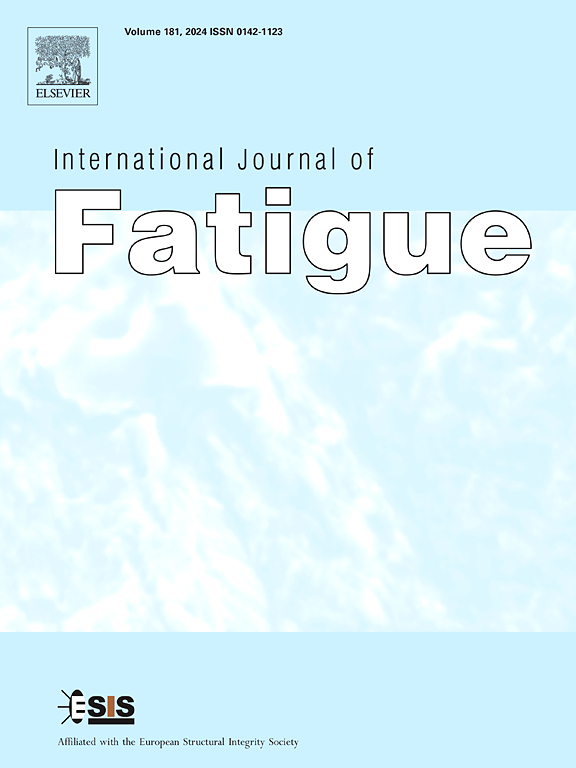Temporal damage accumulation characteristics of plain weave composites under combined high and low cycle fatigue loading employing DIC and AE techniques
IF 6.8
2区 材料科学
Q1 ENGINEERING, MECHANICAL
引用次数: 0
Abstract
In this paper, a novel experimental investigation on the combined high and low cycle fatigue (CCF) behavior of plain weave composites (PWCs) is conducted, utilizing a specially designed fatigue loading block. Digital image correlation (DIC) and acoustic emission (AE) techniques are employed for comprehensive damage characterization. Superimposed high-cycle fatigue (HCF) loading is found to significantly reduce fatigue life, accelerate the accumulation of total and residual strain and lead to earlier damage of weft yarns. A fatigue damage mode identification method is developed by the k-means++ clustering analysis and macro/micro-scale damage observation, classifying fatigue AE signals into four modes. Notably, fatigue damage accumulation characteristics exhibit strong time dependency on the loading history. Under CCF loading, early damage primarily occurs during the HCF stage, while continued cycling causes substantial accumulation in both the load-rise and HCF stages. The superimposed HCF loading contributes to an increased number of cumulative AE hits across all loading stages. The presence of HCF loading maintains a consistently high damage accumulation rate for matrix cracking and fiber/matrix debonding throughout the fatigue process, which is the primary factor contributing to fatigue life reduction.

基于DIC和AE技术的高、低周复合疲劳载荷下平纹编织复合材料的时间损伤累积特征
本文利用一种特殊设计的疲劳加载块,对平纹编织复合材料(PWCs)的高、低周联合疲劳(CCF)行为进行了新颖的实验研究。采用数字图像相关(DIC)和声发射(AE)技术对损伤进行综合表征。研究发现,叠加高周疲劳载荷显著降低了纬纱的疲劳寿命,加速了总应变和残余应变的积累,导致纬纱的早期损伤。通过k-means++聚类分析和宏微观尺度损伤观察,提出了一种疲劳损伤模式识别方法,将疲劳声发射信号划分为4种模式。值得注意的是,疲劳损伤累积特征对加载历史表现出强烈的时间依赖性。在CCF加载下,早期损伤主要发生在HCF阶段,而持续循环在加载上升和HCF阶段都会导致大量累积。叠加的HCF载荷增加了所有加载阶段的累积声发射命中数。在整个疲劳过程中,HCF载荷的存在使基体开裂和纤维/基体脱粘的损伤累积率始终居高不下,这是导致疲劳寿命降低的主要因素。
本文章由计算机程序翻译,如有差异,请以英文原文为准。
求助全文
约1分钟内获得全文
求助全文
来源期刊

International Journal of Fatigue
工程技术-材料科学:综合
CiteScore
10.70
自引率
21.70%
发文量
619
审稿时长
58 days
期刊介绍:
Typical subjects discussed in International Journal of Fatigue address:
Novel fatigue testing and characterization methods (new kinds of fatigue tests, critical evaluation of existing methods, in situ measurement of fatigue degradation, non-contact field measurements)
Multiaxial fatigue and complex loading effects of materials and structures, exploring state-of-the-art concepts in degradation under cyclic loading
Fatigue in the very high cycle regime, including failure mode transitions from surface to subsurface, effects of surface treatment, processing, and loading conditions
Modeling (including degradation processes and related driving forces, multiscale/multi-resolution methods, computational hierarchical and concurrent methods for coupled component and material responses, novel methods for notch root analysis, fracture mechanics, damage mechanics, crack growth kinetics, life prediction and durability, and prediction of stochastic fatigue behavior reflecting microstructure and service conditions)
Models for early stages of fatigue crack formation and growth that explicitly consider microstructure and relevant materials science aspects
Understanding the influence or manufacturing and processing route on fatigue degradation, and embedding this understanding in more predictive schemes for mitigation and design against fatigue
Prognosis and damage state awareness (including sensors, monitoring, methodology, interactive control, accelerated methods, data interpretation)
Applications of technologies associated with fatigue and their implications for structural integrity and reliability. This includes issues related to design, operation and maintenance, i.e., life cycle engineering
Smart materials and structures that can sense and mitigate fatigue degradation
Fatigue of devices and structures at small scales, including effects of process route and surfaces/interfaces.
 求助内容:
求助内容: 应助结果提醒方式:
应助结果提醒方式:


